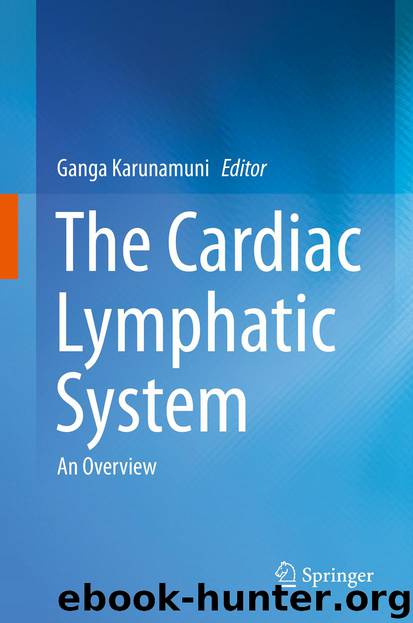The Cardiac Lymphatic System by Ganga Karunamuni

Author:Ganga Karunamuni
Language: eng
Format: epub
Publisher: Springer New York, New York, NY
Targeting Lymphatic Markers
All of the methods described above are dependent on the uptake of the imaging molecules by the lymphatics due to their size and other characteristics. A completely different approach is the specific targeting of imaging agents to the lymphatics through binding to lymphatic-specific markers. Many cell surface molecules have been identified as being specifically expressed on lymphatic endothelial cells and not on blood vessel endothelial cells, such as podoplanin, LYVE-1, Prox-1 and VEGFR3.
Antibodies raised against these molecules can be conjugated to many of the imaging agents described above and used in optical imaging (conjugation to fluorescent molecules), SPECT/CT (conjugation to radionuclides) and ultrasound (conjugation to microbubbles). In the case of ultrasound, an anti-ICAM-1 antibody attached to microbubbles was injected intravenously into rat heart transplant recipients [59]. ICAM-1 becomes upregulated on endothelial cells after their activation. A higher signal was found in rejecting, as opposed to non-rejecting, heart grafts. The authors were thus able to demonstrate the principle of using ultrasound to detect antibody binding to an endothelial cell marker. If an antibody against a lymphatic endothelial-specific marker were used, it should be possible to image lymphatic vessels in the same way. The targeting of imaging agents in this way relieves the need for direct injection into the heart. Labelled agents could be injected intravenously with eventual localisation to the lymphatics.
Antibodies have also been widely used to image lymphatics in the traditional way, on heart transplant biopsy sections. The expression of various lymphatic endothelial cell markers during the first year after clinical heart transplantation has been studied [5]. The expression of both LYVE-1 and Prox-1 was found to decrease after transplantation, while VEGFR3 expression did not. A correlation was also found between lower expression of VEGFR3 and more severe rejection. The same group has used similar techniques to study lymphangiogenesis in terminal heart failure, showing the relevance of studying lymphatics in many diseases of the heart, not just post-transplantation [60]. Similar to this, a decrease in the density of LYVE-1 expressing lymphatic vessels has been shown in rejecting heart allografts in a rat transplantation model [7]. The antibodies used in these studies, bound to imaging agents, could be used in the techniques described above.
Data from transplantation of organs other than the heart also provide information on how the lymphatic system responds to transplantation. Lymphangiogenesis has been demonstrated after human renal transplantation, with new lymphatic vessels associated with tertiary lymphoid organs that develop within the graft [9, 10]. Biopsies from kidney transplant patients have also provided information on the source of the new lymphatic vessels, showing that circulating lymphatic progenitor cells from the recipient are incorporated into the new vessels [3]. Blocking lymphangiogenesis following islet transplantation in mice inhibits the alloimmune response and results in islet preservation [12].
Such studies have provided vital information on the involvement of lymphatics in the alloresponse, but it is the need for serial biopsies of the graft that the development of non-invasive imaging techniques is designed to circumvent.
Download
This site does not store any files on its server. We only index and link to content provided by other sites. Please contact the content providers to delete copyright contents if any and email us, we'll remove relevant links or contents immediately.
| Automotive | Engineering |
| Transportation |
Whiskies Galore by Ian Buxton(41879)
Introduction to Aircraft Design (Cambridge Aerospace Series) by John P. Fielding(33064)
Small Unmanned Fixed-wing Aircraft Design by Andrew J. Keane Andras Sobester James P. Scanlan & András Sóbester & James P. Scanlan(32743)
Craft Beer for the Homebrewer by Michael Agnew(18140)
Turbulence by E. J. Noyes(7936)
The Complete Stick Figure Physics Tutorials by Allen Sarah(7307)
Kaplan MCAT General Chemistry Review by Kaplan(6867)
The Thirst by Nesbo Jo(6826)
Bad Blood by John Carreyrou(6552)
Modelling of Convective Heat and Mass Transfer in Rotating Flows by Igor V. Shevchuk(6391)
Learning SQL by Alan Beaulieu(6211)
Weapons of Math Destruction by Cathy O'Neil(6143)
Man-made Catastrophes and Risk Information Concealment by Dmitry Chernov & Didier Sornette(5921)
Digital Minimalism by Cal Newport;(5664)
Life 3.0: Being Human in the Age of Artificial Intelligence by Tegmark Max(5474)
iGen by Jean M. Twenge(5366)
Secrets of Antigravity Propulsion: Tesla, UFOs, and Classified Aerospace Technology by Ph.D. Paul A. Laviolette(5309)
Design of Trajectory Optimization Approach for Space Maneuver Vehicle Skip Entry Problems by Runqi Chai & Al Savvaris & Antonios Tsourdos & Senchun Chai(5011)
Pale Blue Dot by Carl Sagan(4912)
